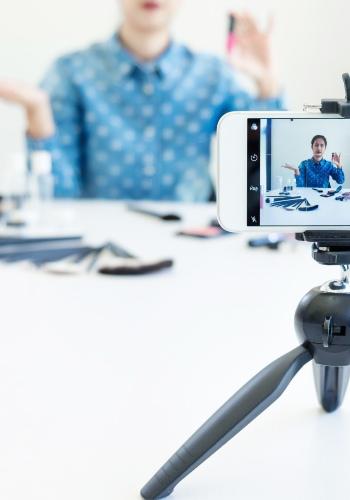Understanding the Importance of Micro-Influencers on Your Business
Build an authentic brand with their help
Unless you’re in the privileged position of being an industry or niche leader, most businesses only have a few thousand followers on social media – if they’re lucky! This is where influencers come in. Influencers are people with large social media followings who are paid to leverage their authority within their niche. They can effectively ‘influence’ their target audience to take an interest in a specific product or service.
Influencer marketing was a trend that became the norm. Consumer behaviour changed with Millennials and Gen Z’ers, as people now want the opinion of a voice they trust before purchasing. Influencer marketing is so effective that it’s now being implemented by most businesses looking to make a serious impact.
Generally speaking, social media influencers are fantastic marketing tools, but micro-influencers have been proven to be incredibly cost-effective at promoting niche products to their dedicated followers. In this article, we’ll discuss how they can make a decisive impact on your marketing campaign.
What are Micro-Influencers?
The exact definition varies depending on who you ask, but if you have between 10,000 and 100,000 followers, you can classify yourself as being within the micro-influencer threshold.
Anything above the threshold is called a macro-influencer, and if you’re above 1 million followers you’re officially in the mega-influencer bracket. The same study also found that, per engagement, these campaigns were 6x more effective when compared to macro-influencers.
Here’s a breakdown:
Micro-influencer – 10,000 – 100,000 followers
Macro-influencer – 100,000 + followers
Mega-influencer – 1,000,000 + followers
They Attract Higher Engagement Rates
Micro-influencers are in the sweet spot for follower count due to the engagement they receive from their often-dedicated audience. A case study by a California-based company, HelloSociety, found that campaigns involving micro-influencers saw a 60% increase in engagement compared to those involving macro-influencers.
It’s understandable that micro-influencers are better at interacting with their followers as the numbers are much more manageable. These constant interactions will lead to a relationship that feels personal and can be compared to one between friends, as opposed to one between a brand and its customers.
They’re Cost-Effective
The influencer industry has seen tremendous growth as a result of the prevalence and popularity of social media in our daily lives. Influencers can leverage their follower count to command hefty fees for sponsored posts and the upper echelons of influencers are sometimes even beyond the reach of major brands, with some able to command up to hundreds of thousands of dollars per post!
Micro-influencers, on the other hand, are happy to post sponsored content for far less, typically within the range of $500 to their engaged audience. The lower costs for these collaborations also mean that you can contact several micro-influencers at one time – increasing your potential engagement and reach.
They’re Authentic
Despite having thousands of followers compared to regular Instagram user, micro-influencers are much more relatable than those with a jet-set lifestyle who post content that the average person can only dream of. Sure, it’s nice to fantasise about similar circumstances, which is why people follow them in the first place, but they’re living a life that’s definitely not relatable.
Whereas mega-influencers tend to have a team of people behind the scenes who assist them with producing extremely polished and high-quality content, micro-influencers are usually highly-motivated solo content creators themselves. Their motivation permeates into everything they do on their account, meaning they’ll go above and beyond the standard approach to sponsored posts to impress both their own audience and the brand that’s paying them!
They Have Niche Audiences
Micro-influencers operate within a niche and focus on a specific interest or topic. Their followers can, therefore, be called a niche audience – a community of closely-knit enthusiasts who are passionate and knowledgeable about one particular area.
If your business produces a niche product or service it would be wise to contact a micro-influencer who is aligned with that niche. For example, a business that creates artisanal, hand-made coffee mugs would be better off contacting an influencer who focuses on ceramic arts & crafts as opposed to someone with 500,000+ followers. Sure the reach will be large, but people are less likely to care. It seems incredibly niche, but there will always be an influencer out there aligned with you.
Drawbacks?
1. Lower Reach
So far we’ve discussed the loyal nature of a smaller audience, but the main disadvantage of a small audience is the potential reach and impressions gained from branded content will be much less.
2. Difficulty With Identification and Management
By nature, micro-influencers are much less established than their better-known counterparts. Finding a potential brand ambassador in a highly specific niche that also aligns with your business philosophy can be time-consuming.
3. They Need Instructions
Collaborating with inexperienced influencers means more time will have to be put towards instructing and educating them on how you want your product to be perceived.
4. Not Their Full-Time Job
It’s rare for a micro-influencer’s main source of income to come from sponsored posts; instead, micro-influencer marketing is usually a supplement to their primary profession. Issues could arise with time management and the prioritisation of their various responsibilities.
Wrap-Up
Working with micro-influencers can be extremely beneficial to your business. Their higher engagement rates, competitive pricing, authenticity and their niche audience should be enough to play a crucial role in your marketing campaign. Finding the right brand ambassador requires research, but once you do, there’s potential for a highly productive relationship.

